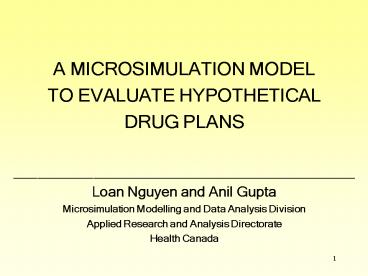A MICROSIMULATION MODEL - PowerPoint PPT Presentation
1 / 11
Title:
A MICROSIMULATION MODEL
Description:
1. A MICROSIMULATION MODEL. TO EVALUATE HYPOTHETICAL. DRUG PLANS. Loan Nguyen and Anil Gupta ... Canada's drug expenditure is the second largest component of ... – PowerPoint PPT presentation
Number of Views:207
Avg rating:3.0/5.0
Title: A MICROSIMULATION MODEL
1
- A MICROSIMULATION MODEL
- TO EVALUATE HYPOTHETICAL
- DRUG PLANS
- ___________________________________________
- Loan Nguyen and Anil Gupta
- Microsimulation Modelling and Data Analysis
Division - Applied Research and Analysis Directorate
- Health Canada
2
Background
- Canadas drug expenditure is the second largest
component of its health care costs - Average annual growth of 9.7 from 1985 to 2003
- Many Canadians with high drug cost and low income
are reported at risk of stopping their drug
treatment - Pressure on the federal/provincial governments to
provide relief to those individuals/families
3
Model Objectives
- Estimate drug benefits for families/ individuals
and the government expenditure under the existing
and new hypothetical drug and tax policies. - Assess the distributional impacts on households
and Federal/Provincial expenditure associated
with a a suite of possible proposal changes - Estimate the Federal/provincial income taxes and
government transfers and credits - Assess the interaction between the drug and tax
policies due to any changes in these two policies
4
Data Requirements
- Model requires individual-level information on
- Socio-demographic characteristics
- Incomes
- Tax deductions/credits
- Drug coverage
- Prescription drugs dispensed
- Health related drug expenditures.
5
Data Sources and Synthesis
SLID - Individual File
Match Health Related Drug Expenditures to SLID
using Statistical Matching
SHS
Synthesized Database
SLID - Census Family File
Simulate information on Tax deductions /
credits using Monte Carlo technique
TAX Data
SLID Economic Family File
Growth Database
Impute Drug coverage Information For Families and
Individuals using Logistic Regression
Validation
NPHS
Simulation Model
Impute Drug Cost and Utilization For
Families /Individuals Using Monte Carlo
Technique
DRUG Data
6
Microsimulation Pharmasim Model
Family Unit
Micro Database
Current Drug Policies
Hypothetical Drug Policies
Option System
Base System
Hypothetical Tax Policies
Current Tax Policies
- Tax Module Calculation
- OAS/GIS, SA contribution
- Net Income, Taxable Income
Exit
Output Data
- Pharmacare Module Calculation
- Estimate Benefits for a family
- unit from individual plans
- Pharmacare Module Calculation
- Estimate Benefits for a family
- unit from family plan
Yes
Acceptable
Select the coverage that optimizes benefits for
the family
Option System Output
Benefits from the Drug Programs
Impact Analysis System
Base System Output
- Tax module Calculation
- Government Transfers
- Tax Credits
7
Application
- An example of income-based national drug coverage
(a hypothetical plan) will be used to illustrate
some of the functions in the model. - Example
- Deductible
- Co-pay after reaching deductible
- Pay only to a maximum
- The above parameters will change with the ability
to pay
8
Application A Hypothetical National Drug
Coverage Plan
9
Application - Questions
- 1) What are the total Provincial costs for
this hypothetical drug coverage plan compared to
the existing provincial drug coverage? - 2) What are the impacts on the households
as a consequence of implementing such a
hypothetical plan, including winner/loser
analysis ?
10
Application - Results
- Compared to the provincial drug plan, the
hypothetical drug plan - has 2.9 higher total Federal/Provincial drug
expenditures - covers 15.9 more individuals or 12.8 more
families - has lower average out-of pocket cost for families
with income under 36,001 and higher for families
with income over 36,000 - covers more families/individuals with low income
(under 36,000) and fewer families/ individuals
with higher income (over 36,000) - has lower average OOP cost for families with
total drug costs less than 100 and greater 750
11
Conclusions /Potential Developments
- Our current model
- Contains a reliable and representative data
source - A highly parameterized and robust policy tool
- Very flexible - can simulate a variety of health
and tax policy options - Useful - can asses the impacts on
federal/provincial revenues and
individual/household drug benefits, including
winner/loser analysis - Future work
- Develop the model for simulating drug benefits
and costs for special diseases - Incorporate health status in the comprehensive
model data to estimate health and disease related
future costs

